Related Research Articles

Fluxus was an international, interdisciplinary community of artists, composers, designers and poets during the 1960s and 1970s who engaged in experimental art performances which emphasized the artistic process over the finished product. Fluxus is known for experimental contributions to different artistic media and disciplines and for generating new art forms. These art forms include intermedia, a term coined by Fluxus artist Dick Higgins; conceptual art, first developed by Henry Flynt, an artist contentiously associated with Fluxus; and video art, first pioneered by Nam June Paik and Wolf Vostell. Dutch gallerist and art critic Harry Ruhé describes Fluxus as "the most radical and experimental art movement of the sixties".

Performance art is an artwork or art exhibition created through actions executed by the artist or other participants. It may be witnessed live or through documentation, spontaneously developed or written, and is traditionally presented to a public in a fine art context in an interdisciplinary mode. Also known as artistic action, it has been developed through the years as a genre of its own in which art is presented live. It had an important and fundamental role in 20th century avant-garde art.

Guerrilla Girls is an anonymous group of feminist, female artists devoted to fighting sexism and racism within the art world. The group formed in New York City in 1985, born out of a picket against the Museum of Modern Art the previous year. The core of the group's work is bringing gender and racial inequality into focus within the greater arts community and society at large. The Guerrilla Girls employ culture jamming in the form of posters, books, billboards, lectures, interviews, public appearances and internet interventions to expose disparities, discrimination, and corruption. They also often use humor in their work to make their serious messages engaging. The Guerrilla Girls are known for their "guerrilla" tactics, hence their name, such as hanging up posters or staging surprise exhibitions. To remain anonymous, members don gorilla masks. To permit individual identities in interviews, they use pseudonyms that refer to deceased female artists such as Frida Kahlo, Käthe Kollwitz, and Alice Neel, as well as writers and activists, such as Gertrude Stein and Harriet Tubman. According to GG1, identities are concealed because issues matter more than individual identities, "Mainly, we wanted the focus to be on the issues, not on our personalities or our own work."
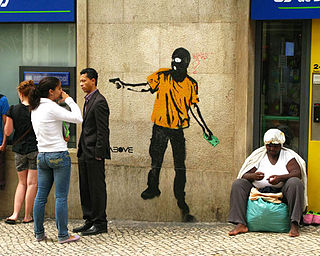
Artivism is a portmanteau word combining art and activism, and is sometimes also referred to as Social Artivism.

Marcel Broodthaers was a Belgian poet, filmmaker, and visual artist.

Faith Ringgold was an American painter, author, mixed media sculptor, performance artist, and intersectional activist, perhaps best known for her narrative quilts.
Art intervention is an interaction with a previously existing artwork, audience, venue/space or situation. It is in the category of conceptual art and is commonly a form of performance art. It is associated with Letterist International, Situationist International, Viennese Actionists, the Dada movement and Neo-Dadaists. More latterly, intervention art has delivered Guerrilla art, street art plus the Stuckists have made extensive use of it to affect perceptions of artworks they oppose and as a protest against existing interventions.

Scott Tyler, known professionally as Dread Scott, is an American artist whose works, often participatory in nature, focus on the experience of African Americans in the contemporary United States. His first major work, What Is the Proper Way to Display a U.S. Flag (1989), was at the center of a controversy regarding whether his piece resulted in desecration of the American flag. Scott would later be one of the defendants in United States v. Eichman, a Supreme Court case in which it was eventually decided that federal laws banning flag desecration were unconstitutional.

Barkley L. Hendricks was a contemporary American painter who made pioneering contributions to Black portraiture and conceptualism. While he worked in a variety of media and genres throughout his career, Hendricks' best known work took the form of life-sized painted oil portraits of Black Americans.
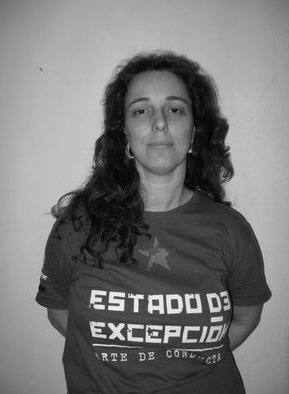
Tania Bruguera is a Cuban artist and activist who focuses on installation and performance art. She lives in Cambridge, Massachusetts where she works as head of media and performance at Harvard University. Bruguera has participated in numerous international exhibitions. her work is in the permanent collections of many institutions, including the Museum of Modern Art and Bronx Museum of the Arts and the Museo Nacional de Bellas Artes de La Habana.
The Women's Caucus for Art (WCA), founded in 1972, is a non-profit organization based in New York City, which supports women artists, art historians, students, educators, and museum professionals. The WCA holds exhibitions and conferences to promote women artists and their works and recognizes the talents of artists through their annual Lifetime Achievement Award. Since 1975 it has been a United Nations-affiliated non-governmental organization (NGO), which has broadened its influence beyond the United States. Within the WCA are several special interest causes including the Women of Color caucus, Eco-Art Caucus, Jewish Women Artist Network, International Caucus and the Young Women's Caucus. The founding of the WCA is seen as a "great stride" in the feminist art movement.
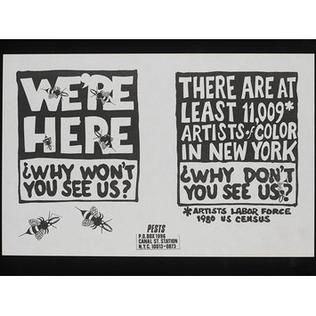
PESTS was an anonymous American activist group formed in 1986 to critique racism, tokenism, and exclusion in the art world. PESTS produced newsletters, posters, and other print material highlighting examples of discrimination in gallery representation and museum exhibitions. PESTS also publicized events and exhibits featuring artists, scholars, and curators of color.

The Harlem on My Mind protests were a series of protest actions in New York, organized by the Black Emergency Cultural Coalition (BECC) in early 1969 in response to the Metropolitan Museum of Art's exhibition Harlem on My Mind: Cultural Capital of Black America. The exhibition, focused on the Harlem Renaissance and intended as the museum's first show exploring the cultural achievements and contributions of African Americans, was heavily criticized by black audiences for not actually including any art by black artists, instead presenting documentary photographs and murals of the Harlem neighborhood, and for the exhibition's inclusion of several racist and anti-Semitic statements. The BECC - a group of African-American contemporary artists and activists that formed in response to the exhibition - organized a series of boycotts and protests outside and inside the museum before and after the show opened, leading to national news coverage and a series of institutional responses from the museum.
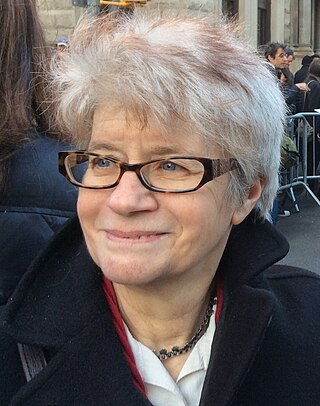
Marjorie Kramer is a figurative painter of al fresco landscapes and feminist self-portraits.
Ad Hoc Committee of Women Artists or Ad Hoc Women Artists' Committee was founded in 1970 and included members from Women Artists in Revolution (WAR), the Art Workers' Coalition (AWC) and Women Students and Artists for Black Art Liberation (WSABAL). Founding members included Lucy Lippard, Poppy Johnson, Brenda Miller, Faith Ringgold and later, Nancy Spero.
Tom Lloyd (1929–1996) was an American sculptor, activist and community organizer.
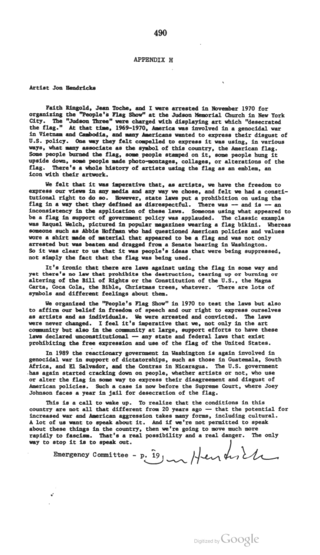
The People's Flag Show was a November 1970 exhibition at Judson Memorial Church in New York City by Faith Ringgold, Jean Toche and Jon Hendricks, known as the Judson Three. The exhibition was raided by the police and the artists arrested on a charge of flag desecration. They were convicted and fined $100 each, but this was later overturned with support from the New York Civil Liberties Union.
Queer art, also known as LGBT+ art or queer aesthetics, broadly refers to modern and contemporary visual art practices that draw on lesbian, gay, bisexual, transgender, and various non-heterosexual, non-cisgender imagery and issues. While by definition there can be no singular "queer art", contemporary artists who identify their practices as queer often call upon "utopian and dystopian alternatives to the ordinary, adopt outlaw stances, embrace criminality and opacity, and forge unprecedented kinships and relationships." Queer art is also occasionally very much about sex and the embracing of unauthorised desires.

The American People Series #20: Die is an oil on canvas painting made by American artist Faith Ringgold in 1967. Inspired by Pablo Picasso's painting Guernica (1937) and painted amidst the riots and uprisings of the 1960s, Die is a two-panel work depicting a group of Black and white men, women, and children, most of whom are wounded or covered in blood, variously fighting, fleeing, or dying against an abstract grey background. The piece has been extensively cited as among Ringgold's most important and iconic artworks.
Jon Hendricks is an American artist, curator and political activist. Since 2008, he has served as the Fluxus Consulting Curator of the Gilbert and Lila Silverman Collection at the Museum of Modern Art (MoMA).
References
- 1 2 "Jean Toche | artist memo". no-art.info. Retrieved 2021-05-27.
- ↑ "Revolutionary Instances and Activism in Art Practices at the turn of the 60s and 70s. Two cases compared: Hi Red Center and Guerilla Art Action Group | LuxFlux" . Retrieved 2021-05-27.
- ↑ Kimmelman, Michael (1997-05-02). "Art in Review". The New York Times.
- ↑ "Guerrilla Art Action Group | InEnArt" . Retrieved 2021-05-28.
- 1 2 Russeth, Andrew (2016-12-08). "'Freedom of Speech Is Absolutely Imperative': Faith Ringgold on Her Early Art, Activism at the Museum of Modern Art". ARTnews.com.
- ↑ Ho, Melissa; Crow, Thomas; Levin, Erica; Nixon, Mignon; Rosler, Martha (2019-04-02). Artists Respond: American Art and the Vietnam War, 1965–1975. Princeton University Press. ISBN 978-0-691-19118-8.
- ↑ "3 ARRESTED IN RAID ON FLAG ART SHOW". The New York Times. 1970-11-14.
- ↑ "FLAG SHOW ARTISTS FINED $100 APIECE". The New York Times. 1971-05-25.
- ↑ Gray, John (1993). Action Art: A Bibliography of Artists' Performance from Futurism to Fluxus and Beyond. ABC-CLIO. ISBN 978-0-313-28916-3.
- ↑ "Artist Here Charged In Kidnapping Threats". The New York Times. 1974-03-28.
- 1 2 "UNITED STATES v. VAN IMSC | 390 F.Supp. 994 (1974) | upp99411229 | Leagle.com". Leagle.
- ↑ Scavone, Jason; Sunday, Special to The (2016-09-26). "In this wild election cycle, protest art stirs up outrage, delight and conversation - Las Vegas Sun Newspaper". lasvegassun.com.
- ↑ "Jean Toche 1932–2018". Tate.